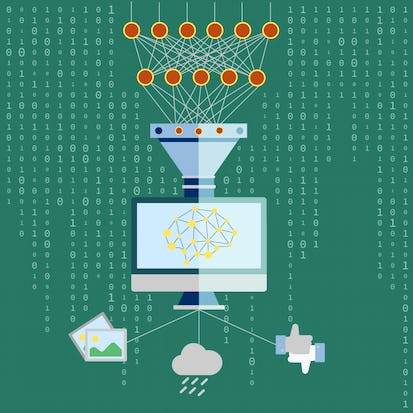- Level Professional
- المدة 21 ساعات hours
- الطبع بواسطة Duke University
-
Offered by

عن
This course will provide you a foundational understanding of machine learning models (logistic regression, multilayer perceptrons, convolutional neural networks, natural language processing, etc.) as well as demonstrate how these models can solve complex problems in a variety of industries, from medical diagnostics to image recognition to text prediction. In addition, we have designed practice exercises that will give you hands-on experience implementing these data science models on data sets. These practice exercises will teach you how to implement machine learning algorithms with PyTorch, open source libraries used by leading tech companies in the machine learning field (e.g., Google, NVIDIA, CocaCola, eBay, Snapchat, Uber and many more).الوحدات
Logistic Regression
2
Assignment
- Intro to Machine Learning
- Logistic Regression
1
Labs
- Python Prerequisites
5
Videos
- Why Machine Learning Is Exciting
- What Is Machine Learning?
- Logistic Regression
- Interpretation of Logistic Regression
- Motivation for Multilayer Perceptron
2
Readings
- Course Information
- Math for Data Science
Multilayer Perceptron
4
Assignment
- Multilayer Perceptron
- Deep Learning
- Model Selection
- History of Neural Networks
8
Videos
- Multilayer Perceptron Concepts
- Multilayer Perceptron Math Model
- Deep Learning
- Example: Document Analysis
- Interpretation of Multilayer Perceptron
- Transfer Learning
- Model Selection
- Early History of Neural Networks
Convolutional Neural Networks
2
Assignment
- CNN Concepts
- CNN Math Model
6
Videos
- Hierarchical Structure of Images
- Convolution Filters
- Convolutional Neural Network
- CNN Math Model
- How the Model Learns
- Advantages of Hierarchical Features
Applications in the Real World
2
Assignment
- Applications In Use and Practice
- Week 1 Comprehensive
2
Labs
- PyTorch Installation
- Coding Environments
3
Videos
- CNN on Real Images
- Applications in Use and Practice
- Deep Learning and Transfer Learning
PyTorch Basics
1
Videos
- Introduction to PyTorch
Logistic Regression as Running Example
1
Assignment
- Lesson One
2
Videos
- How Do We Define Learning?
- How Do We Evaluate Our Networks?
Learning via Gradient Descent
1
Assignment
- Lesson 2
3
Videos
- How Do We Learn Our Network?
- How Do We Handle Big Data?
- Early Stopping
Model Learning with PyTorch
1
Assignment
- Week 2 Comprehensive
2
Labs
- Logistic Regression
- Multi-Layer Perceptron (MLP) Assignment
1
Videos
- Model Learning with PyTorch
Convolutional Neural Network Basics
1
Assignment
- Lesson One
2
Videos
- Motivation: Diabetic Retinopathy
- Breakdown of the Convolution (1D and 2D)
Core Components of the Network
1
Assignment
- Lesson 2
3
Videos
- Core Components of the Convolutional Layer
- Activation Functions
- Pooling and Fully Connected Layers
CNN Implementation
1
Assignment
- Lesson 3
2
Videos
- Training the Network
- Transfer Learning and Fine-Tuning
Convolutional Neural Networks with PyTorch
1
Assignment
- Week 3 Comprehensive
2
Labs
- Convolutional Neural Networks
- CNN Assignment
1
Videos
- CNN with PyTorch
Word embeddings
1
Assignment
- Lesson 1
3
Videos
- Introduction to the Concept of Word Vectors
- Words to Vectors
- Example of Word Embeddings
Representative example NLP problem: Sentiment Analysis
1
Assignment
- Lesson 2
4
Videos
- Neural Model of Text
- The Softmax Function
- Methods for Learning Model Parameters
- More Details on How to Learn Model Parameters
Recurrent Neural Networks and Long Short-Term Memory
1
Assignment
- Lesson 3
4
Videos
- The Recurrent Neural Network
- Long Short-Term Memory
- Long Short-Term Memory Review
- Use of LSTM for Text Synthesis
Alternative Approaches
1
Assignment
- Week 4 Comprehensive
1
Videos
- Simple and Effective Alternative Methods for Neural NLP
Natural Language Processing with PyTorch
2
Labs
- Natural Language Processing
- Natural Language Processing Assignment
1
Videos
- Natural Language Processing with PyTorch
Inner Products
4
Videos
- Word Vectors and Their Interpretation
- Relationships Between Word Vectors
- Inner Products Between Word Vectors
- Intuition Into Meaning of Inner Products of Word Vectors
Attention Mechanism
3
Videos
- Introduction of Attention Mechanism
- Queries, Keys, and Values of Attention Network
- Self-Attention and Positional Encodings
Sequence-to-Sequence Encoder and Decoder
3
Videos
- Attention-Based Sequence Encoder
- Coupling the Sequence Encoder and Decoder
- Cross Attention in the Sequence-to-Sequence Model
The Transformer Network
2
Videos
- Multi-Head Attention
- The Complete Transformer Network
Reinforcement Learning
1
Assignment
- Reinforcement Learning Quiz
2
Labs
- Reinforcement Learning
- Reinforcement Learning Assignment
4
Videos
- Introduction to Reinforcement Learning
- Reinforcement Learning Problem Setup
- Example of Reinforcement Learning in Practice
- Reinforcement Learning with PyTorch
Q Learning
1
Assignment
- Q Learning Quiz
3
Videos
- Moving to a Non-Myopic Policy
- Q Learning
- Extensions of Q Learning
Deep Q Learning
1
Assignment
- Deep Q Learning Quiz
3
Videos
- Limitations of Q Learning, and Introduction to Deep Q Learning
- Deep Q Learning Based on Images
- Connecting Deep Q Learning with Conventional Q Learning
Auto Summary
Join Coursera's "Introduction to Machine Learning" to master foundational machine learning models like logistic regression and convolutional neural networks. Led by industry experts, this professional-level course spans 1260 minutes and offers hands-on exercises with PyTorch. Ideal for aspiring data scientists, it covers applications from medical diagnostics to image recognition. Flexible subscription options include Starter, Professional, and Paid plans.

Lawrence Carin

David Carlson

Timothy Dunn

Kevin Liang


